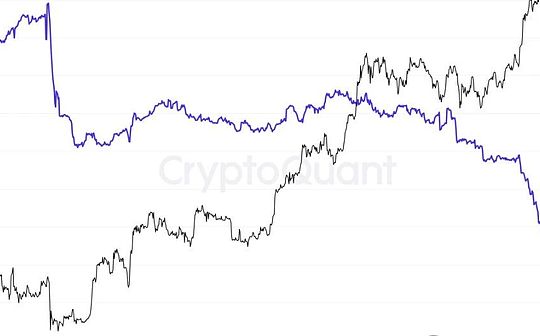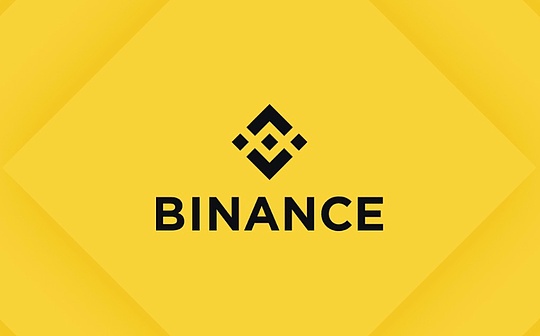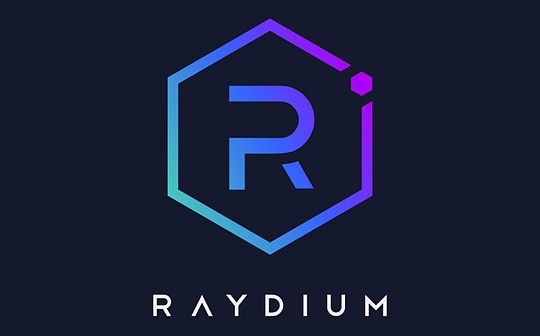Institutions "break up" with Ethereum but still can't let go of ETH

転載元: jinse
04/26/2025·1MAuthor: Yohan Yun Source: cointelegraph Translation: Shan Oppa, Golden Finance
Ethereum is at one of the most critical moments since its inception. The usage of underlying networks is declining sharply, with core data approaching years of lows, and even co-founder Vitalik Buterin has put forward radical suggestions for radical reform of the Ethereum architecture .
And institutional investors no longer wait for the results. On-chain data shows that long-time backers like Galaxy Digital and Paradigm have cut their Ethereum (ETH) positions in recent weeks.
So far, throughout April, activity on the Ethereum mainnet has continued to decline: network fees have decreased, but inflation has been rising . Although layer two networks are still booming, they are eroding the value- bearing capabilities of the main network .
However, things are not just the "collapse" of Ethereum. Some giant whales regard this downturn as a rare opportunity to buy at the bottom . Even those institutions that are selling ETH have not completely abandoned it.
**Institutions "abandon" Ethereum, but are they really going their
separate ways?**
These institutions seem to be "breaking up", but they can't let go of this "ex-in-law". Instead of completely blocking ETH, they "refrigerated" it while trying "new objects" like Solana.
In recent weeks, on-chain analysts have found multiple institutions transferring large amounts of ETH from their tagged wallets, most likely for sale. Lookonchain reports that Galaxy Digital has transferred 65,600 ETHs to Binance (worth about $105.5 million). The company previously held about 98,000 ETH in February, and has now dropped to around 68,000 (data from Arkham).

Although Galaxy's ETH holdings have declined recently, they are still at a high level compared to the beginning of the year . This also reflects the overall trend of Ethereum's investment products. According to CoinShares, $26.7 million of outflows in ETH investment funds over the past week, with a cumulative outflow of up to $772 million in the past eight weeks. However, net inflows from the beginning of the year to date remained at US$215 million .
Meanwhile, Galaxy also pulled out 752,240 SOLs (worth about $98.37 million). Some of Ethereum's market popularity was stolen by Solana - especially in the memecoin craze from 2024 to early 2025, Solana became the main battlefield. Although the craze eventually cooled down by scams, robotic operations and inferior projects, it also demonstrated Solana's technical strength - maintaining low fees and no major downtime under high transaction volumes.
Paradigm is also another investment institution that cuts its ETH position. On April 21, the company transferred 5,500 ETH (about $8.66 million) to Anchorage Digital. According to on-chain analyst EmberCN, Paradigm has transferred about 97,000 ETH (worth about US$301.57 million) to Anchorage since January 2024, and then flowed to centralized exchanges.
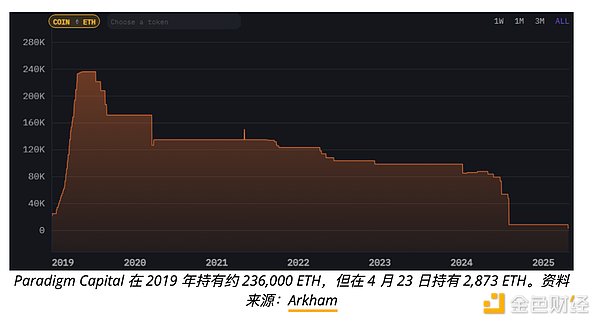
"While institutional investors initially bought ETH based on the narrative of 'supersonic currency', today they are facing real-world problems of declining protocol revenue and deteriorating token economic model," said Jayendra Jog, co-founder of Sei Labs, to Cointelegraph.
Ethereum returns to "inflation" state
The deflationary characteristics of ETH were once an important selling point to attract investors. This mechanism was introduced into the Ethereum network through two major upgrades. First, the London hard fork in August 2021 introduced the EIP-1559 proposal, which burned some transaction fees; then the merger (The Merge) upgrade in September 2022 , and Ethereum officially converted to a Proof of Stake (PoS) mechanism, significantly reducing the issuance of New Coins.
After the merger upgrade, the total supply of ETH continued to decline until April 2024 , ETH began to re-enter inflation. By early February 2025 , the total supply of ETH had exceeded the level at the time of the merger .
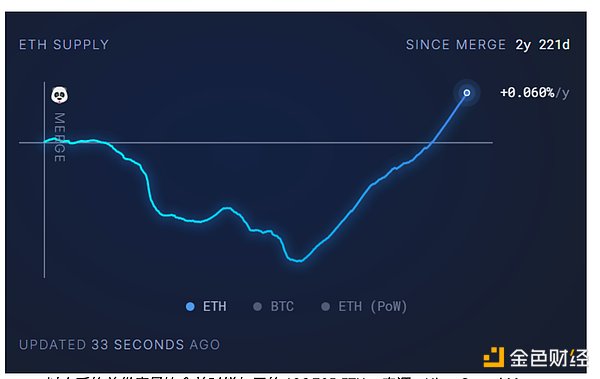
ETH inflation is partly due to a sharp drop in network fees, resulting in a decrease in the amount of ETH destroyed. According to data from IntoTheBlock, from April 14 to 21, 2024, the Ethereum network charged a handling fee of 1,873.52 ETH . This is slightly higher than the 1,697.61 ETH for the week on March 17, which was the lowest fees (priced by ETH) since July 31, 2017 .
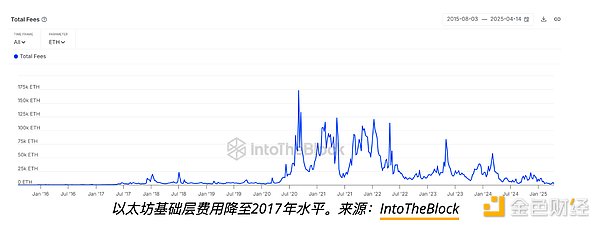
Vitalik proposes radical proposal: Replace EVM with RISC-V
On April 20, Vitalik Buterin proposed to replace the current Ethereum Virtual Machine (EVM) instruction set with RISC-V architecture to improve the speed and efficiency of the network execution layer. Some people see this move as a signal of "surrender" to the existing architecture.

Sei Labs co-founder Jayendra Jog commented: Vitalik's RISC-V proposal is essentially an admission that the underlying architecture of EVM has hit its limits. When the founders of Ethereum personally proposed to replace the core virtual machines that underpin the entire ecosystem, this was not evolution, but awareness of a design bottleneck that could not be improved in an incremental way.
The background of this proposal is that the Ethereum Foundation has recently undergone a round of leadership adjustments, and the controversy and criticism of the future direction of Ethereum in the community is also heating up.
Will Ethereum be the "missed opportunity"?
Ethereum’s current dilemma stems in part from its R rollup centralized scaling strategy . The core concept of this strategy is to transfer transactions from the main chain by building a Layer 2 expansion network, but still take advantage of the security of the Ethereum main chain. This does alleviate congestion during peak networks, but it also brings new challenges such as reduced ETH destruction and ecosystem fragmentation.
However, according to Tomasz Stańczak , the new co-executive director of the Ethereum Foundation, the community 's attention to Layer 1 expansion is increasing . Stańczak posted on the X platform that the Ethereum Foundation will refocus on its near-term goals, mainly including the expansion of Layer 1 and support for the expansion of Layer 2 .
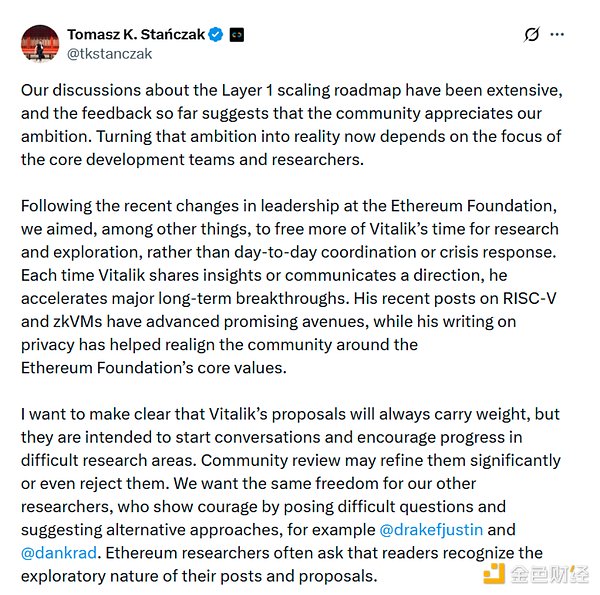
At the same time, some giant whales began to buy at low levels while Ethereum prices were pulling back. On April 23 , blockchain monitoring platform Lookonchain discovered that two addresses are accumulating ETH worth millions of dollars. On April 22 , Lookonchain also found that another wallet has purchased more than $100 million in ETH since February 15 .
ETH's current price has fallen from its high of more than $4,000 in December last year, but rose more than 10% on April 23 , returning to more than $1,800 .
Standard Chartered recently lowered its 2025 ETH price forecast from $10,000 in a letter to clients. However, for whales currently on dips, ETH still has upward potential - the bank still maintains its target price of $4,000 at the end of the year .
Geoff Kendrick, head of digital assets research at Standard Chartered Bank, said this more conservative outlook is mainly due to the structural weakness of Ethereum. He pointed out that the fee income that should have been obtained from the main chain has now been "diverged" by a large number of Layer 2 networks, which also weakens the main chain's economic model.

